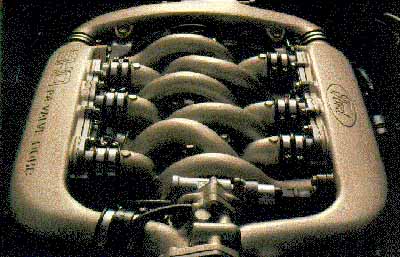 Ford Taurus SHO - Engine
Ford Taurus SHO - Engine
For more on the SHO engine, see Performance
SHO Thermostat
An SHO that is running too cold is usually because of a thermostat that is either corroded or stuck open. Ford makes a revised 'B' thermostat that solves this problem. Remember to put in a new gasket. It's also a smart idea to replace the temperature sender and add a bottle of RedLine Water Wetter anti-corrosion agent.
There are two thermostats for the SHO, a 180°F and a 190°F. While the 190°F is recommended for better performance and
gas mileage, for weather hotter than 90°F some use the 180°F to keep the car safe and cool.
SHO Radiator
Like many Fords, the Ford Taurus SHO uses an aluminum core with plastic tanks for its radiators. This design saves weight. Unfortunately, the crimp connection between the plastic tanks and the aluminum core has a tendency to leak. Since as re-crimping of the tanks does not last, the only way to fix this design problem is to replace the radiator. For warm climates and high performance SHOs, a double core radiator is strongly recommended. Double core radiators offer twice the thickness of the factory radiator (requires slight modifications to fit).
The SHO engine does not like to be overheated for even short periods of time. This cannot be over-emphasized.
Just a few minutes overheating can result in a warped head and blown head gaskets, resulting in a repair bill higher
than the cost of buying a used SHO. If you see the temperature gauge in the "O" of "NORMAL" instead of the "M" where it
belongs, get help immediately. If the gauge is higher than that stop the car and do not drive it, even if it is
drivable. Driving an overheated SHO for even a few minutes can result in irreversible damage that won't show up until
thousands of miles later. Even if the cooling system is repaired after that, the damage is done and the head gasket will
blow a few thousand miles later. It is not a matter of "if", but "when". Believe me, I know.
A severely overheated SHO engine will at first refuse to start. If you hold the key, it may eventually start but only do that if your personal situation is the utmost emergency as every second driving an overheated engine is dangerou$$$. Trust me, it's cheaper to just get a tow - or hey, better yet, just join AAA like I did and take advantage of their excellent towing benefits for members.
SHO Coolant Hoses
Coolant hoses should be replaced everySHO Ford Water Pump
The average life of a water pump for the SHO is about 120K miles. When the water pump begins to fail there will be a slow leak at the bottom of the pump Below the pump is a Crankshaft Position Sensor (CPS). When hot coolant drips onto this sensor, it will shut off, stopping the engine until the sensor cools down. If your Taurus SHO is suddenly stalling for no apparent reason, check your coolant pump for leaks. It's strongly recommended that you replace the CPS when replacing the water pump.SHO Heater Core
The heater core is a defect in some Ford Taurus SHOs. That's because the heater core is connected by rubber hoses and insulated from the car body. When a hot fluid moves through a metal tube it develops a static charge. This static charge gradually degrades the heater core until leaks begin to develop. That's why some, but not all, SHOs have a grounding strap from one of the metal heater core tubes to car body ground. If your SHO does not have a grounding strap you better install one before you begin to develop leaks.
Leaks in the heater core become evident by fogging of the car windows, followed by slowly lowering coolant levels. Replacing the heater core is a bear of a job that is more painful and costly than a root canal..
Fuel Pump
You'll know your fuel pump is going when you hear a loud whining sound from the back of the car. Ford put a high capacity 112 LPH fuel pump in the 5-speed SHO, which is strong enough for a 330 horsepower engine. Unfortunately, while the Automatic SHO was supposed to have the same pump, for some reason some Automatic SHOs received the standard 65 LPH pump You can't tell unless you pull the pump. If you have an Automatic SHO and you've got a few extra dollars, you might want to check your fuel pump and replace it if it's one of the smaller ones.Fuel Injectors
While fuel injector failure is very rare, varnish can build up on the injectors. It's a good idea to replace the injectors when you do your valve lash service. Aside from that, you should clean your fuel system every 50K miles.Fuel Filter
Replace it every 15K miles. It's cheap and easy to do, and will do wonders for keeping your engine healthy.Camshaft Position Sensor
While standing at front of the car looking at the engine, the camshaft sensor is on the left hand side, at the rearmost camshaft, next to the shock tower. It is about 2-1/2" in diameter and about 1/2" thick. If the car stalls unexpectedly, or has an unusually rough idle, you should run the EEC-IV diagnostic codes to see if you have a bad camshaft sensor. Right next to the camshaft position sensor is the spout connector.Spark Plugs
Use only the Motorcraft Double Platinum Plug and never use anything else. 'nuff said.Spark Plug Wires
Often overlooked, regular replacement of spark plug wires will keep your SHO flying like a bat out of hell. Because of the high voltages shooting through these wires, they need to be replaced every 80K miles. You'll be amazed at the difference!
Ignition Module
The Distributor Ignition System module (DIS) rarely fails. When it does, it is almost always caused by overheating because of a warm environment. It sits on the side of that beautiful intake manifold and is remarkably easy to replace.
EEC-IV Engine Control Module
The EEC-IV module sits right behind your glove compartment. You should never see a failure of that module unless you are driving late at night in a thunderstorm in Rhode Island and your car gets hit by lightening (like me).
Also see http://www.fordfuelinjection.com/

